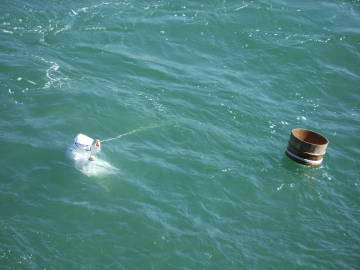|
Pearl DiversFor centuries, if you wanted pearls...yup..you dived for them or hired pearl divers.
A fellow student, who didn't laugh, quickly looked it up in the textbook and poked me in the ribs, saying, "Look, it says here, both are acceptable." Now, back to pearl diving... With the development of cultured pearls, this is no longer necessary to hire pearl divers, unless, it's natural pearls you're wanting....and who wouldn't want natural pearls, they are still the most highly sought after and prized pearls in the world. Today, divers have equipment to handle pressure problems, but in days gone by...there was no such equipment. I've spoken to local guys here by the Mississippi River at Muscatine, Iowa who are pearl divers...well, shell divers, really, but find pearls too. One man said he mostly found elongated black pearls here. Another said he saw a huge pink pearl and was thrilled to buy a long freshwater pink pearl necklace from me for his wife. Still others find pearl in mussels they gather to use for fishing, like my two young friends who live on the Mississippi River's edge and found three pearls one day. Wow, was their mom glad to get these gifts! These are guys my age or younger, not some really old men who used to do this long ago...it's still a hobby today. My mother tells me about pearl divers looking also in the Minnesota River close to my childhood home and finding pearls. But, the Mississippi River isn't deep enough to cause the same problems for divers as an deep, deep ocean. I'm sure rivers have difficulties of their own, like maybe being quite murky, perhaps. Technical problems that can occur with diversI'll now explain some technical problems that can occur to pearl divers going deeply into water. When a pearl diver descends, the sea pressure around him increases one atmosphere for each ten meters. To prevent the collapse of his alveoli (microscopic bubble-like sacs that carry on respiration in the lungs), he must be supplied with air under high pressure. Because most common gas in the air is nitrogen, the deep-sea diver absorbs a large amount of nitrogen into his body fluids. At sea level an adult has about one liter of nitrogen dissolved in his body. A person who has been subjected to high-pressure air at a depth of one hundred meters has about ten liters of nitrogen dissolved in the body. If he ascends gradually, he will be able to exhale the nitrogen at the same rate that it diffuses into his blood. If he ascents rapidly, however, large amounts of nitrogen will be released quickly and may form bubbles in his bloodstream. These bubble may block the circulation of blood, thereby damaging body tissues by depriving them of oxygen and causing pain in the joints, dizziness, fainting and paralysis. These painful symptoms, known as the "bends," often causes the victim to bend forward. There is no possible acclimatization to the bends. The only safe way to relieve these symptoms is to recompress the affected person (by diving or in a high-pressure chamber called a decompression chamber) so that the bubbles redissolve in his body fluids. Then the pressure may be reduced slowly so the nitrogen diffuses into the blood slowly enough to be exhaled from the lungs and not form bubbles. So.....the next time you take some fancy to join the pearl divers be sure you know fully what you're up against and get prepared with equipment and instructions...then you come up straight, hopefully with some giant pearls, and won't get the bends. Video of Persian Gulf pearl diving.
|












